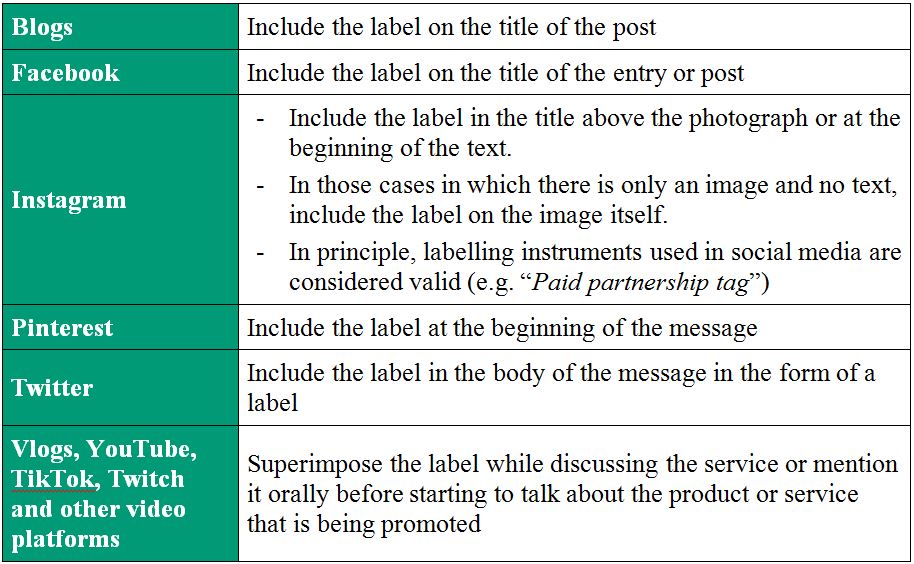Autocontrol and Asociación Española de Anunciantes (Spanish Advertisers’ Association or AEA) agree on the ethical standards that should be applied to advertising by influencers from January 1, 2021. It clarifies doubts about ‘safe’ labels such as “ad” or “sponsored by”, when they should be used and the contractual obligations that members should follow. We summarize the code below.
The aim behind the ethical framework agreed by Autocontrol and the AEA in the Code of Conduct on the use of influencers in advertising (2020) is to introduce clear guidelines to help companies and influencers comply with the general principles of advertising and, specifically, with the principle of ‘authenticity’ and, the prohibition on surreptitious advertising. This was a very necessary step in view of the increasing importance of influencers. According to the InfoAdex Study 2020, the year-on-year growth of influencer marketing stands at 67.1%, receiving investment of over 61.8 million euros. Consequently, it is now necessary to analyze the main rules introduced by the Influencers’ Code of Conduct and bring the company’s policies and practices into line with the code. Let’s take a look.
1. Who must comply with the ethical standards of the Influencers’ Code of Conduct?
We are dealing with self-regulation, so the ethical standards of the Influencers’ Code of Conduct only apply to companies and influencers that are members of Autocontrol or the AEA. It is Autocontrol’s Advertising Jury that will be in charge of ensuring that the rules of the code are adhered to. Autocontrol will also be authorized to monitor the effective compliance with the Code by companies and influencers that have signed up to it.
Autocontrol also ‘polices’ the activity of companies that have not signed up, and reserves the right to issue guidelines recommending the withdrawal of advertising that does not comply with its rules. In this case, companies and influencers that are not bound by the code and, therefore, they do not have a ‘legal’ obligation to comply with its rules. Nevertheless, the publication of a decision that concludes that the code of ethics has been breached can have a negative impact on the reputation of the company and/or the influencer affected.
2. Does the code affect the procedure for hiring influencers?
Yes. Companies adhered to the code must inform the influencers they hire of the existence of the code and the obligations it contains. The recommendations, which are in principle ethical, come under the law on contracts and therefore, the breach of the agreed rules may lead to a breach of contract.
In addition, this obligation means that the informal practices that are followed when hiring influencers must be dropped, and minimum standards, preferably in writing, must be established determining the parties’ obligations, a practice we have been wholeheartedly recommending for years.
3. Which type of content must comply with the code’s rules?
Only advertising content is subject to the rules of the code. However, since it is not always easy to determine when content is advertising content or editorial content, the code establishes a series of criteria that should be followed to determine whether or not we are dealing with an advertising message. It states as follows:
“References or content – graphic, audio or visual – that are cumulatively
- aimed at promoting goods or services;
- disseminated in the context of reciprocal collaborations or commitments, in which the content is disseminated for a fee or other type of consideration by the advertiser or its representatives;
- the advertiser or its agents hold editorial control over the content disseminated (establishing beforehand all or part of same and/or validating it)
are deemed to be advertising content”
It is important to bear in mind that as far as consideration is concerned it is irrelevant whether payment is in cash or in kind. The code expressly establishes that the “free delivery of product, free tickets to events, free provision of a service, gift vouchers, free bags and trips” are also consideration.
Conversely, as is to be expected, content that is purely editorial or which the influencer publishes spontaneously on his/her own initiative, without a relationship with the advertiser, cannot be considered “advertising” and is therefore not subject to the rules of the code.
4. Must all advertising be identified?
The code establishes the obligation we have been talking about for some time that posts by influencers or the contents they disseminate must be identifiable as advertising. But does this mean that all posts and content must labelled? The answer is no. The code only requires the use of labels “when it is not clear from the post or content that it is advertising”. It remains to be seen, in view of the decisions that are yet to come, how Autocontrol’s Advertising Jury will interpret this rule.
Whether or not the message constitutes advertising must be interpreted from the standpoint of the average consumer, who the code defines as “an active consumer who is familiar with new information technologies, is reasonably observant and circumspect and has the capacity to access and understand digital media and the autonomy to search for, discriminate between and adapt online content while browsing according to his/her tastes or interests”.
In addition, the introduction of the code includes a very interesting interpretative principle that takes in not just the technical skills of users of social networks and internet platforms, but also the type of public that follows the influencer:
“Throughout their career, influencers use a language, format and communication codes that have allowed them to create and continue to increase their followers, who are usually regular followers who are in tune with the influencer, with the way they communicate and with their language. This regularity, makes it possible to define with a certain degree of objectiveness, the average profile of followers that the content or message will impact, and therefore the interpretation that is made of the principle of identification of the advertising should be in light of such profile”.
Accordingly, the code follows case law by the Court of Justice of the European Union and the Spanish courts, in establishing that the meaning of the advertising should be interpreted in light of how the recipients of the message will perceive it. The truth is that a YouTube channel aimed at minors is not the same as a microinfluencer publishing scientific information.
5. What labels should we use when identifying a post or content as advertising?
The code requires that labels used for posts or content be “explicit, immediate and adequate in view of the medium and message”. That is, no specific labels are imposed and companies and influencers are free to make their own. A series of labels that are considered ‘safe’ are indicated, together with others that do not meet the necessary requirements of clarity to make the advertising message clear:

It also establishes the obligation to maintain the label used in the original content or post when the influencer shares or “reposts” the content on other social media or websites.
6. When should the label be visible?
When the label is displayed in the post or content is also important, since, generally speaking, labels that require intervention by the user cannot be used. That is, if the user has to click on or browse through the content before seeing the label that reveals that the message is advertising, the label will not have complied with the “immediacy” requirement established in the code, since users will have accessed the content before knowing that it is advertising.
In this regard, the code providers a series of guidelines applicable to different social media which, although intended as a guide are very helpful to companies and influencers that do not want to run any risks:

Cristina Mesa Sánchez
Intellectual Property Department






